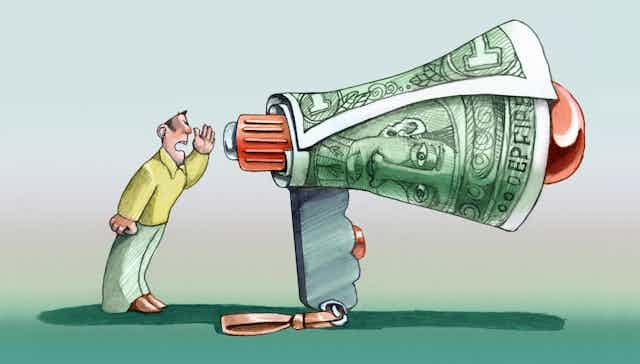Americans spend mind-blowing amounts of money on their elections. According to the Federal Election Commission (FEC) in the 2016 presidential election cycle the candidates spent a total of US$1.6 billion (£1.2 billion). This rose to US$4.1 billion in the 2020 cycle, and it is likely to be much higher in the current election campaign.
Donations to presidential campaign funds come from individuals, political parties and political action committees (Pacs). The latter pool contributions from supporters to promote or oppose candidates, as well as raising money in the first place. They are legally independent from the campaign funds raised by candidates and parties, but they act in concert with them, for example, by funding ads which support the policies and positions taken by their candidates.
Political campaigns in the US are very expensive because they run on for a long time and involve costly advertising. As soon as a new president is elected, preparations begin for the midterm congressional elections two years later, as well as the next round of presidential primaries.
The FEC updates the figures on money raised and spent on the 2024 presidential election campaign on a continuous basis. At the time of writing the 2024 presidential campaign has already raised a total of just over US$397 million by all the candidates, and spent just under US$294 million since January 2021. The Republicans have raised US$225 million and the Democrats $103 million.
As regards spending, the Republicans have spent US$191 million and the Democrats US$48 million on the 2024 election campaign so far. These sums do not include the money raised by congressional and state-level campaigns, but just relate to presidential hopefuls.
The big discrepancy between the two parties in spending is because Joe Biden has no significant rivals for the Democratic party nomination, but the Republicans started out with nine candidates certified by the Republican National Committee. Spending by these hopefuls adds to the total raised.
Around 18% of the population gave money to a candidate or a party in the presidential election contest of 2020, according to the American National Election Study. It is likely these small donations from individuals are largely motivated by their attachment to a party or a candidate.
Donations from corporations to Pacs supporting the candidates often reflect a strategy of “hedging”, or giving money to both sides in order not to upset the winner if they back the loser. For example, the OpenSecrets website which tracks money in US politics, shows that Exxon Mobile gave 58% of its political donations to the Republicans and 42% to the Democrats (in 2020).
Costly challenges to Trump
Donald Trump is facing a number of different challenges to his fundraising. By mid February he had raised less money than the president, and there are some signs that January’s fundraising was particularly strong.
The FEC data shows that Biden has raised around US$92 million so far in this year’s campaign, whereas Donald Trump’s total is just under US$85.3 million. This represents the Biden and Trump totals out of the money spent by all presidential candidates up to this point.

In the 2020 election, Trump’s voting support was unsurprisingly strongest in the Republican-supporting states, which tend to be poorer than Democratic-supporting states. This means that he is likely to get less money from individual donations than Biden.
The gap between incomes in “red” (Republican) and “blue” (Democrat) states has been growing over time, so this problem is likely to get worse as the election approaches.
Another problem for him is that so-called “dark money” donations from rich individuals in 2020 overwhelmingly favoured the Democrats rather than the Republicans. Dark money refers to anonymous donations from the very wealthy via organisations described as “super Pacs”. In 2020 these donations exceeded US$1 billion, so they are really important.
According to OpenSecrets, Biden received US$174 million of dark money compared with only US$25 million for Trump. This premium for Biden may be even larger than in 2020 if, as seems likely, Trump gets the Republican nomination.
One interesting development is that Haley has been receiving significant sums from rich donors in her challenge to Trump for the Republican nomination. Even though her bid is a long shot, these donors clearly prefer her to Trump.
Finally, Trump is facing US$83 million in fines following a guilty verdict from a New York jury in a sexual assault case against columnist E. Jean Carroll. In a second case relating to his business empire in New York, the judge has ruled that fraud was committed and fined him a total of US$355 million.
The FEC is keeping a close eye on campaign finance, so he will be well advised to resist the temptation to use campaign funds to pay off these fines, since this would be illegal.
Overall, this means that the ex-president is likely to be outspent by a large margin by Biden’s campaign. But does this make a difference to the election outcome?
Recent research confirms consistent findings that campaign spending in US elections has a significant impact on support for candidates, although it tends to mobilise people to vote rather than to switch support between candidates.
This means that the more the Democrats outspend the Republicans in the 2024 campaign the greater the chance that Joe Biden will beat Donald Trump, or vice versa.


